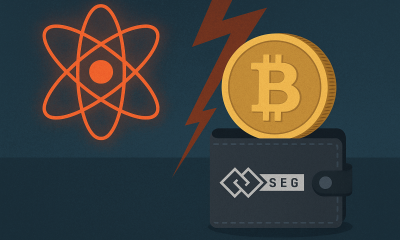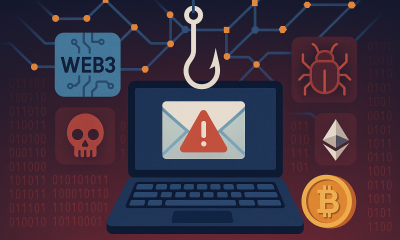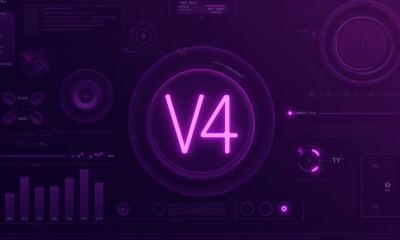

Metaverse
Why tech giants want to strangle AI with red tape – Crypto News
One of the joys of writing about business is that rare moment when you realise conventions are shifting in front of you. It brings a shiver down the spine. Vaingloriously, you start scribbling down every detail of your surroundings, as if you are drafting the opening lines of a bestseller. It happened to your columnist recently in San Francisco, sitting in the pristine offices of Anthropic, a darling of the artificial-intelligence (AI) scene. When Jack Clark, one of Anthropic’s co-founders, drew an analogy between the Baruch Plan, a (failed) effort in 1946 to put the world’s atomic weapons under UN control, and the need for global co-ordination to prevent the proliferation of harmful AI, there was that old familiar tingle. When entrepreneurs compare their creations, even tangentially, to nuclear bombs, it feels like a turning point.
Since ChatGPT burst onto the scene late last year there has been no shortage of angst about the existential risks posed by AI. But this is different. Listen to some of the field’s pioneers and they are less worried about a dystopian future when machines outthink humans, and more about the dangers lurking within the stuff they are making now. ChatGPT is an example of “generative” ai, which creates humanlike content based on its analysis of texts, images and sounds on the internet. Sam Altman, CEO of OpenAI, the startup that built it, told a congressional hearing this month that regulatory intervention is critical to manage the risks of the increasingly powerful “large language models” (LLMs) behind the bots.
In the absence of rules, some of his counterparts in San Francisco say they have already set up back channels with government officials in Washington, DC, to discuss the potential harms discovered while examining their chatbots. These include toxic material, such as racism, and dangerous capabilities, like child-grooming or bomb-making. Mustafa Suleyman, co-founder of Inflection AI (and board member of The Economist’s parent company), plans in coming weeks to offer generous bounties to hackers who can discover vulnerabilities in his firm’s digital talking companion, Pi.
Such caution makes this incipient tech boom look different from the past—at least on the surface. As usual, venture capital is rolling in. But unlike the “move fast and break things” approach of yesteryear, many of the startup pitches now are first and foremost about safety. The old Silicon Valley adage about regulation—that it is better to ask for forgiveness than permission—has been jettisoned. Startups such as OpenAI, Anthropic and Inflection are so keen to convey the idea that they won’t sacrifice safety just to make money that they have put in place corporate structures that constrain profit-maximisation.
Another way in which this boom looks different is that the startups building their proprietary LLMs aren’t aiming to overturn the existing big-tech hierarchy. In fact they may help consolidate it. That is because their relationships with the tech giants leading in the race for generative AI are symbiotic. OpenAI is joined at the hip to Microsoft, a big investor that uses the former’s technology to improve its software and search products. Alphabet’s Google has a sizeable stake in Anthropic; on May 23rd the startup announced its latest funding round of $450m, which included more investment from the tech giant. Making their business ties even tighter, the young firms rely on big tech’s cloud-computing platforms to train their models on oceans of data, which enable the chatbots to behave like human interlocutors.
Like the startups, Microsoft and Google are keen to show they take safety seriously—even as they battle each other fiercely in the chatbot race. They, too, argue that new rules are needed and that international co-operation on overseeing LLMs is essential. As Alphabet’s CEO, Sundar Pichai, put it, “AI is too important not to regulate, and too important not to regulate well.”
Such overtures may be perfectly justified by the risks of misinformation, electoral manipulation, terrorism, job disruption and other potential hazards that increasingly powerful AI models may spawn. Yet it is worth bearing in mind that regulation will also bring benefits to the tech giants. That is because it tends to reinforce existing market structures, creating costs that incumbents find easiest to bear, and raising barriers to entry.
This is important. If big tech uses regulation to fortify its position at the commanding heights of generative AI, there is a trade-off. The giants are more likely to deploy the technology to make their existing products better than to replace them altogether. They will seek to protect their core businesses (enterprise software in Microsoft’s case and search in Google’s). Instead of ushering in an era of Schumpeterian creative destruction, it will serve as a reminder that large incumbents currently control the innovation process—what some call “creative accumulation”. The technology may end up being less revolutionary than it could be.
LLaMA on the loose
Such an outcome is not a foregone conclusion. One of the wild cards is open-source AI, which has proliferated since March when LLaMa, the LLM developed by Meta, leaked online. Already the buzz in Silicon Valley is that open-source developers are able to build generative-AI models that are almost as good as the existing proprietary ones, and hundredths of the cost.
Anthropic’s Mr Clark describes open-source AI as a “very troubling concept”. Though it is a good way of speeding up innovation, it is also inherently hard to control, whether in the hands of a hostile state or a 17-year-old ransomware-maker. Such concerns will be thrashed out as the world’s regulatory bodies grapple with generative AI. Microsoft and Google—and, by extension, their startup charges—have much deeper pockets than open-source developers to handle whatever the regulators come up with. They also have more at stake in preserving the stability of the information-technology system that has turned them into titans. For once, the desire for safety and for profits may be aligned.
© 2023, The Economist Newspaper Limited. All rights reserved.
From The Economist, published under licence. The original content can be found on www.economist.com
“Exciting news! Mint is now on WhatsApp Channels 🚀 Subscribe today by clicking the link and stay updated with the latest financial insights!” Click here!
Download The Mint News App to get Daily Market Updates.
Updated: 03 Oct 2023, 12:44 PM IST
-

 Blockchain1 week ago
Blockchain1 week agoXRP ETFs Listed On DTCC Ahead Of Possible Launch – Crypto News
-

 Blockchain1 week ago
Blockchain1 week agoEthereum (ETH) Holds Strong as Analysts Target $4,400 Despite ETF Outflows – Crypto News
-

 Cryptocurrency6 days ago
Cryptocurrency6 days agoVanEck’s Solana ETF nears launch after SEC 8-A filing – Details – Crypto News
-

 Cryptocurrency6 days ago
Cryptocurrency6 days agoVanEck’s Solana ETF nears launch after SEC 8-A filing – Details – Crypto News
-
Technology1 week ago
Breaking: Coinbase Launches Token Sales Platform for Retail Investors – Crypto News
-
Business5 days ago
December Fed Meeting 2025: Rate Cut or Hold? Key levels to Watch – Crypto News
-
Business1 week ago
Breaking: Coinbase Launches Token Sales Platform for Retail Investors – Crypto News
-

 De-fi7 days ago
De-fi7 days agoZEC Jumps as Winklevoss‑Backed Cypherpunk Reveals $100M Zcash Treasury – Crypto News
-

 Metaverse1 week ago
Metaverse1 week agoWhat’s in India’s first AI rulebook? – Crypto News
-

 Cryptocurrency1 week ago
Cryptocurrency1 week agoHow Strive’s $162M Bitcoin bet could make it the next MicroStrategy – Crypto News
-

 De-fi6 days ago
De-fi6 days agoKraken’s xStocks Hit $10B in Total Trading Volume – Crypto News
-
others5 days ago
December Fed Meeting 2025: Rate Cut or Hold? Key levels to Watch – Crypto News
-

 Metaverse5 days ago
Metaverse5 days agoClaude Desktop is your new best friend for an organized PC – Crypto News
-

 Cryptocurrency1 week ago
Cryptocurrency1 week agoBitcoin faces quantum risk: why SegWit wallets may offer limited protection – Crypto News
-

 Blockchain1 week ago
Blockchain1 week agoSquare Enables Bitcoin Payments for Sellers – Crypto News
-

 De-fi1 week ago
De-fi1 week agoBitcoin Hovers Around $105,000 as Government Shutdown Progress Lifts Markets – Crypto News
-
others1 week ago
Breaking: Canary XRP ETF Gets Approval with 8-A Filing to List on Nasdaq – Crypto News
-

 Metaverse1 week ago
Metaverse1 week agoYour deep research tool may save you time, but can it save you embarrassment? – Crypto News
-

 De-fi1 week ago
De-fi1 week agoXPL Rallies After Plasma Reveals Collaboration with Daylight Energy – Crypto News
-

 De-fi1 week ago
De-fi1 week agoSKY Surges 14% as Savings TVL Passes $4 Billion – Crypto News
-

 Metaverse5 days ago
Metaverse5 days agoClaude Desktop is your new best friend for an organized PC – Crypto News
-

 Technology1 week ago
Technology1 week agoEU Eyes Banning Huawei From Mobile Networks of Member Countries – Crypto News
-

 De-fi1 week ago
De-fi1 week agoMonad Faces Community Backlash After Unveiling Tokenomics – Crypto News
-

 others1 week ago
others1 week agoGold retreats from three-week high but retains bullish outlook – Crypto News
-

 De-fi1 week ago
De-fi1 week agoThreshold Network Upgrades tBTC Bridge to Link Institutional Bitcoin with DeFi – Crypto News
-

 De-fi1 week ago
De-fi1 week agoEthereum Sees First Sustained Validator Exit Since Proof-of-Stake Shift – Crypto News
-

 Cryptocurrency1 week ago
Cryptocurrency1 week agoXRP’s Big Moment? Why Nov. 13 Could Be the Day Ripple Investors Have Waited For – Crypto News
-

 De-fi1 week ago
De-fi1 week agoTrump Tokens Outperform After US President Teases ‘Tariff Dividends’ – Crypto News
-

 Metaverse1 week ago
Metaverse1 week agoFoxconn reports strong Q3 profit driven by AI server boom, teases OpenAI announcement – Crypto News
-

 Cryptocurrency1 week ago
Cryptocurrency1 week agoBitcoin (BTC) battles macro headwinds despite improved ETF inflows – Crypto News
-

 Cryptocurrency1 week ago
Cryptocurrency1 week agoAI-driven phishing scams and hidden crypto exploits shake Web3 security – Crypto News
-

 Blockchain7 days ago
Blockchain7 days agoWhy the Future of Blockchain Payments Could Stay Narrow – Crypto News
-

 others1 week ago
others1 week agoAustralian Dollar loses ground despite stronger Westpac Consumer Confidence – Crypto News
-
others1 week ago
Bitcoin News: BTC Exchange Reserves Fall as Tether Mints $1B USDT – Crypto News
-

 Blockchain1 week ago
Blockchain1 week agoXRP Price Resumes Uptrend Amid Renewed Market Optimism and Whale Activity – Crypto News
-

 De-fi1 week ago
De-fi1 week agoInstitutional Sentiment is Turning Bearish on Crypto: Sygnum – Crypto News
-
Cryptocurrency1 week ago
Can Dogecoin Price Hold Above $0.17 Amid Weekly Surge? – Crypto News
-

 Technology1 week ago
Technology1 week agoChinas cryptoqueen jailed in UK over $6.6 billion Bitcoin scam – Crypto News
-

 Blockchain1 week ago
Blockchain1 week agoBitcoin Path To $1 Million Clears With OG Sellers Fading: Weisberger – Crypto News
-
Technology1 week ago
Breaking: USDC Issuer Circle Explores Native Token for Arc Network – Crypto News
-
others1 week ago
Hyperliquid Halts Deposits and Withdrawals Amid POPCAT Liquidation Saga – Crypto News
-
Business1 week ago
Hyperliquid Halts Deposits and Withdrawals Amid POPCAT Liquidation Saga – Crypto News
-

 De-fi1 week ago
De-fi1 week agoFlare TVL Nears Record High as Firelight Teases XRP Liquid Staking – Crypto News
-

 De-fi6 days ago
De-fi6 days agoXRP Surges as First US Spot ETF Debuts on Nasdaq – Crypto News
-

 Cryptocurrency6 days ago
Cryptocurrency6 days agoUAE makes Bitcoin wallets a crime risk in global tech crackdown – Crypto News
-

 De-fi5 days ago
De-fi5 days agoBitcoin Drops to $94,000 Following Second-Largest Daily ETF Outflows – Crypto News
-

 De-fi5 days ago
De-fi5 days agoBitcoin Drops to $94,000 Following Second-Largest Daily ETF Outflows – Crypto News
-

 Technology4 days ago
Technology4 days agoPerplexity faces harsh crowd verdict at major San Francisco AI conference: ‘Most likely to flop’ – Crypto News
-
Business1 week ago
Arthur Hayes Buys UNI as CryptoQuant CEO Says Supply Shock ‘Inevitable’ for Uniswap – Crypto News
-
Business1 week ago
U.S. Government Shutdown Set to End as House Panel Approves Senate Funding Deal – Crypto News










